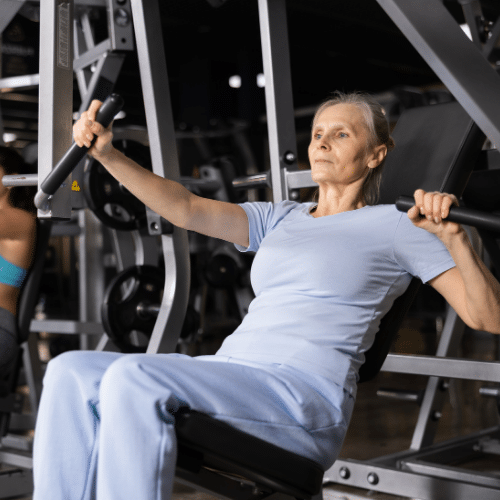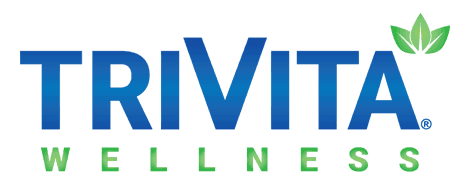Why Strength Training?
As we age, our muscles naturally begin to weaken. This process, called sarcopenia, can start as early as our 30s, but it accelerates after the age of 50. Without intervention, the loss of muscle mass can lead to reduced mobility, balance issues, and a greater risk of falls and injuries. Fortunately, strength training can slow and even reverse the effects of sarcopenia.
Here are some key benefits of strength training for those over 50:
- Increased Muscle Mass: Regular strength training helps rebuild and maintain muscle mass, which is crucial for everyday tasks needed for independent living, such as climbing stairs, lifting groceries, and getting out of a chair.
- Bone Health: As we age, our bones naturally lose density, which increases the risk of fractures and osteoporosis. Strength training puts healthy stress on bones, encouraging them to become denser and stronger.

- Improved Balance and Stability: Falls are a major concern for people over 50, often leading to serious injuries. Strengthening muscles, particularly in the legs and core, can improve balance and stability, reducing the likelihood of falls.
- Better Joint Health: Strength training increases the strength of muscles that support joints, alleviating pain and improving mobility in people with arthritis or joint issues.
- Enhanced Metabolism: Muscle burns more calories than fat, even at rest. By building muscle, you can increase your resting metabolic rate, helping you manage your weight more easily as you age.
- Mental Health Benefits: Strength training improves physical health and boosts mental well-being. Studies show that resistance training can reduce symptoms of anxiety and depression, improve cognitive function, and enhance mood.
- Increased Independence: Maintaining strength increases your likelihood of staying independent longer. This means you can continue performing everyday activities without assistance, contributing to a higher quality of life as you age.
Common Myths about Strength Training and Aging
Despite the numerous benefits, many people over 50 hesitate to start strength training due to common myths. Let’s dispel some of these misconceptions:
- Myth 1: Strength Training is Dangerous for Older Adults: With proper form, guidance, and a gradual progression, strength training is one of the safest exercises for older adults. In fact, it reduces the risk of injury by strengthening the muscles and bones that support joints and prevent falls.
- Myth 2: Strength Training is Only for the Young: It’s never too late to start! Studies show that even individuals in their 80s and 90s can see improvements in muscle strength and overall function when they begin a strength training routine.
- Myth 3: You Need Expensive Equipment: While gym machines and weights are helpful, they are unnecessary. Bodyweight exercises like squats, push-ups, and planks can be incredibly effective. Resistance bands and small dumbbells are affordable options for home workouts.
- Myth 4: Strength Training Makes You Bulky: This fear is common, particularly among women, but it’s not a reality. Building large muscles requires a specific diet and training regimen that most people over 50 are not following. Strength training will help you become leaner, not bulkier.
Starting a Strength Training Routine After 50
The good news is that strength training doesn’t require much time to be effective. I spend just 3-4 hours per week doing resistance training, and I can not only see but also feel the difference. Just two to three sessions per week, focusing on all the major muscle groups, can produce noticeable results.

Here are some tips for getting started:
- Start Slow: If you’re new to strength training, it’s essential to start slowly to avoid injury. Begin with lighter weights or resistance bands and focus on learning the proper form before increasing resistance. Bodyweight exercises are a great starting point.
- Focus on Functional Movements: Exercises that mimic everyday movements are particularly beneficial. Squats, for example, mimic the movement of sitting down and standing up, while arm curls resemble the action of picking something up.
- Work All Major Muscle Groups: To get the full benefits of strength training, be sure to target all major muscle groups: legs, back, chest, arms, and core. You don’t need to do all of them in one session but aim to hit each group at least once a week.
- Prioritize Form Over Weight: Lifting heavy weights with poor form can lead to injury. Focus on maintaining proper posture and movement throughout each exercise. If needed, consult a personal trainer or watch online tutorials for guidance.
- Incorporate Rest Days: Recovery is essential to any strength training program. Your muscles need time to repair and strengthen after a workout, so include rest days in your routine.
Key Exercises for People Over 50
Below are a few beginner-friendly exercises that are great for building strength, improving balance, and enhancing overall function:
- Squats: Squats are excellent for strengthening your legs and core. They mimic the motion of sitting and standing, making them highly functional. If you need extra support, try holding onto the back of a chair or a wall as you lower yourself.
- Push-ups: Push-ups strengthen your chest, shoulders, and arms. If traditional push-ups are too challenging, try doing them on your knees or standing and pushing off a wall.
- Planks: Planks strengthen your core, which is crucial for maintaining balance and posture. Start with short holds (10-15 seconds) and gradually increase the time as you build strength.
- Deadlifts: Deadlifts work multiple muscles, including your back, legs, and core. You can perform deadlifts with a pair of dumbbells or a resistance band. Be sure to maintain proper form to protect your lower back.
- Glute Bridges: Glute bridges strengthen your hips, glutes, and lower back. Lie on your back with your knees bent and feet flat on the floor. Lift your hips towards the ceiling and squeeze your glutes at the top before lowering back down.
- Step-Ups: Step-ups are a simple yet effective exercise for improving leg strength and balance. Use a sturdy platform or a low step and alternate stepping up with each leg.
Integrating Strength Training into Your Life
For people over 50, strength training doesn’t need to be complicated or time-consuming. You can start by dedicating just 20 to 30 minutes a few times a week to these exercises. The key is consistency. Over time, you will notice your strength, mobility, and overall health improvements.
It’s also important to remember that strength training should complement other types of physical activity. Walking, swimming, yoga, and stretching are all excellent additions to your fitness routine. They create a well-rounded program that enhances cardiovascular health, flexibility, and mental well-being.
Nutrition Matters
Strength training is most effective when paired with proper nutrition. As we age, our bodies need more protein to maintain and build muscle. Be sure to include plenty of lean proteins like chicken, fish, beans, and legumes in your diet. Calcium and vitamin D are essential for maintaining bone health, so incorporate dairy products or fortified alternatives into your meals.

Essential Amino Acids are critical for building healthy muscle, joint tissue, and every other body cell. Proteins are made up of branched amino acids. We can make some amino acids, but 9 of them cannot be made by the body and must be obtained by diet. Many people don’t know that as we age, we do not break proteins down as efficiently. I take essential amino acids during my workouts to help my body recover faster after a workout.
Some people have joint problems, which make strength training difficult. I have referred countless people to taking joint tissue-building glucosamine and chondroitin to support healthy joints. Many people consume turmeric for its anti-inflammatory benefits, but very few curcuminoids are absorbed. Taking an advanced formula turmeric supplement allows the consumer to get 95% curcuminoids absorbed, so if you deal with pain during workouts, you should consider changing turmeric.
Staying hydrated is also crucial for muscle function, so drink plenty of water throughout the day, especially before and after workouts. I like infusing my water with a hydrogen water bottle and drinking it before and during my workout. According to current research, consuming hydrogen-rich water (hydrogen water) may potentially increase energy and stamina by reducing fatigue.






